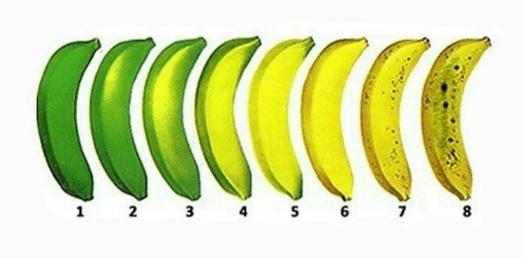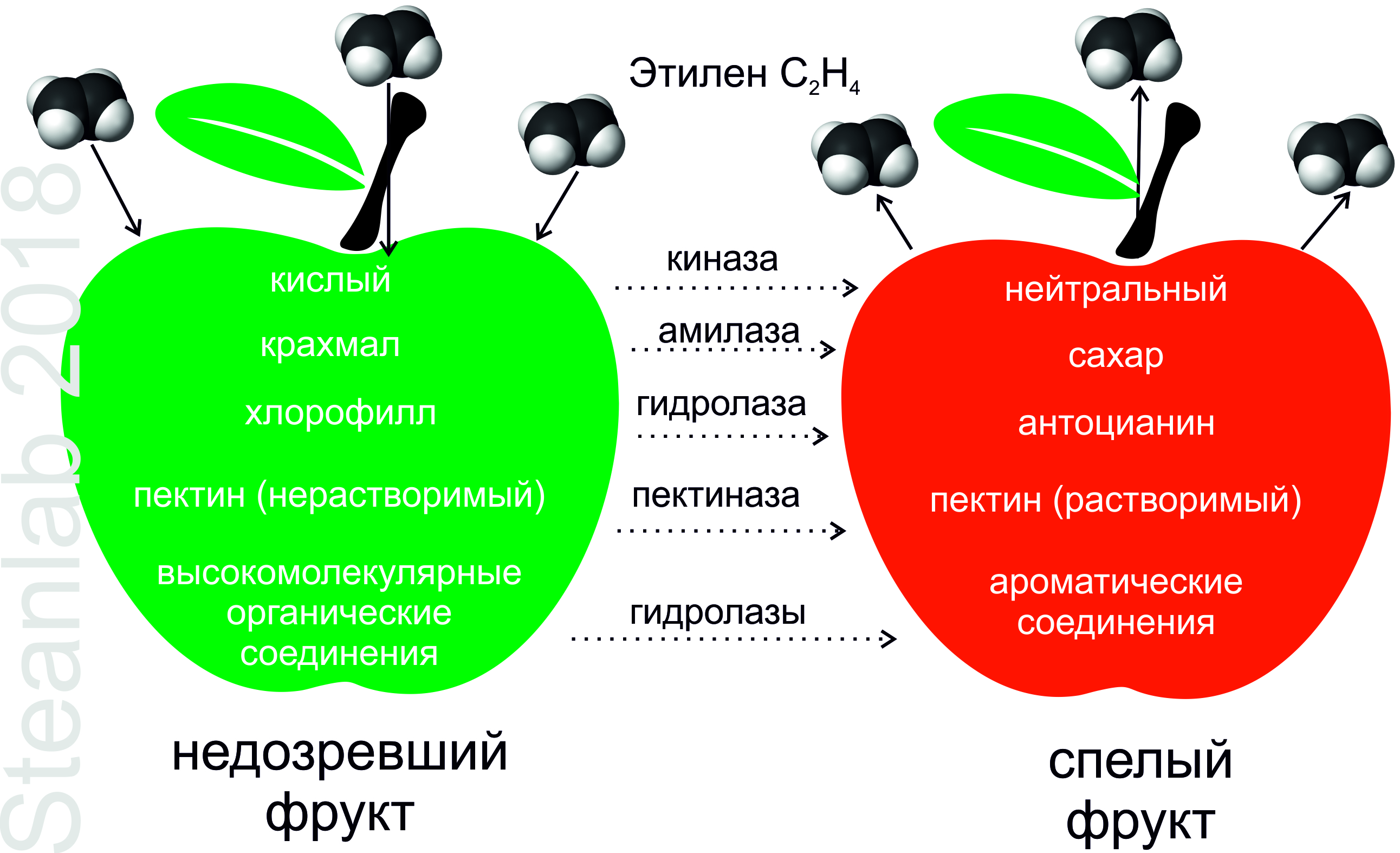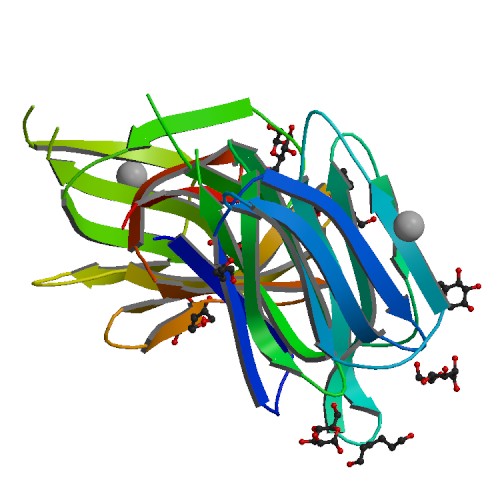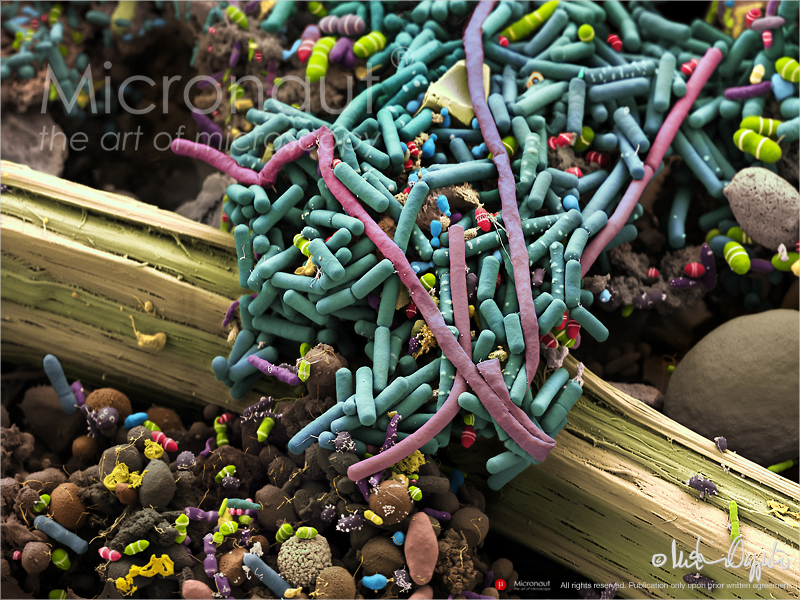Notes phytochemist. Green Banana, or Do not forget to feed the microbiota
As it has already happened since the days of a hungry student youth, I often bought myself bananas for the rest of my money, and not chips or buckwheat. The reasons for this probably can be many, from "bananas are cheaper than potatoes in Belarus", to "bananas, like chocolate, promote brain activity." But the fact remains. If persimmon is a seasonal fruit, then a banana is such a thing that accompanies us throughout life all the time. How not to repay a debt and not to drop a note. In addition, about the mini-survey I conducted among my friends, one of the main fruits, which with a probability of 99% will be on almost every New Year's table, is also a banana. But the right banana still need to find ...
In general, for the "warm-up" I suggest a rapid test. What do you think, which of the bananas in the picture has the maximum healing effect according to Chinese researchers? To get started, just select and remember the number under the picture you like.

Well, for the answer - traditionally, under the cat.
Even in recent times, here and there we could meet stray actors preachers who had an undeniable, " banana argument " in their zagashnik, against any atheist. The key element of this argument was such a picture, invented by Comrade Raymond "Ray" Comfort aka Banana Man - a creationist, Christian (Protestant) writer, street preacher and video producer.

- The banana has a shape that is comfortable to grip with the human hand.
(most likely meant that the number of ribs on the sides of a banana coincides with the number of joints between the phalanxes of the exciting fingers) - Banana has a non-slippery surface.
(well ...) - Banana has external indicators of content readiness for use: green is too early, yellow is what you need, black is too late
(but not so simple, read the article below) - The banana has an opener for skinning.
(I open it from the pointed end, but there are so many opinions about people) - Banana has a perforated "skinned package"
(well ...) - Banana has a biodegradable “skinned package”
(I agree) - Banana has a shape that fits the size of a human mouth.
(???) - The banana is pointed at the top to make it easier to eat.
(???) - Banana is pleasant to taste buds.
(especially wild :)) - The banana is twisted along the face to make the whole process of eating more ergonomic
(there is such a creative (more than) German artist Karl Friedrich Lentze who invented a car that straightens bananas, and there is no end to those who want to buy this car :))
I do not know about you, but to me, without any further thought about divine providence (mentally thanking the unknown agro-selectionists and geneticists) , like the proposed description of the strengths of the banana. Therefore, today about him. We will consider the medicinal components later, because now, when there are only a few days left before the New Year, it is much more important to choose the right banana. For with what you will celebrate the New Year, in order to spend it.
So what about the gas?
Periodically, I hear about people who buy bananas, the phrase that they say "they are treated with some kind of gas," which means that you are not mine - it is all the same harmful. In fact, this fallacy absolutely has no fundamental basis. To prove this, you have to talk about plant hormones. Let's start from afar.
One of the key moments in the phenomenon of "banana" is its degree of maturity. So how exactly does this factor affect the taste characteristics. Bananas that are exported are collected in green "starch" and, without noticeable changes in their condition, are quietly transported around the world in refrigerators at a temperature of + 13-15 ° C (56.3 and 59.0 ° F). At lower temperatures, bananas turn black due to the destruction of the cell walls (which can be observed by holding them in a refrigerator at 4 ° C), although inside the fruit remains unchanged. By the way, they are in such a state for quite a long time, until they rot ("still not reaching maturity"). Some national cuisines (Jamaican, for example) use such green bananas as foodstuffs with a high starch content, therefore many suppliers offer “bananas without gas” to the market, i.e. those over which the procedure of aeration is not carried out. But we love yellow and sweet bananas, and for this you need to start the mechanism of forced ripening. This is done already in the destination country, in special aeration cells (ripening). For processing, bananas from relatively cool storage rooms are transferred to a thermally insulated gassing chamber, where the bananas first warm up to + 18–20 ° C, and then the chamber is filled with so-called. "Banana gas" - a mixture of nitrogen (95%) and ethylene (5%).

Daily exposure in a gas atmosphere starts the ripening process, and after storage in a normal atmosphere for three to seven days, bananas are ready for sale. The degree of ripeness of bananas is controlled by the parameters of aeration and the duration of storage in the warehouse. The picture, in fact, shows instructions for the camera ripening camera (degrees in Fahrenheit, if someone wants to make such a camera at home, translated using the formula (Fahrenheit - 32): 1.8 = Celsius).

By the way, a characteristic feature of an unripe banana (besides color) is pronounced longitudinal edges (ribs) on fruits; ripe banana has an almost circular cross-section, without pronounced edges.
The main component in this whole procedure is ethylene gas. Many probably have heard / seen about plant growth stimulants (for example, about auxins or gibberellins) with the help of which everyone is able to grow his miracle fruit at home. This includes ethylene gas, for it is the simplest representative of plant hormones (yes, plants also have their own hormones ).
Phytohormones - low molecular weight organic substances produced by plants and having regulatory functions. They act in very low concentrations, cause various physiological and morphological changes in parts of plants sensitive to their action.
They are not afraid of ethylene, since all plants synthesize it, with the exception of algae, as well as mushrooms and some bacteria. The rate of formation of ethylene in plant tissues averages 5-50 nl / h (g wet weight), and the content is 0.1-2.0 nl / g wet weight. A lot of ethylene accumulates in falling leaves and flowers, in the nodes of the shoots. The ripening fruits are particularly high in ethylene. For example, in apples, its concentration reaches 2500 nl / g wet weight. Like other phytohormones, ethylene controls many processes in plants, many of which are induced by stress (flooding, cooling or high temperatures, pathogens, drought). That is why often ethylene is also called stress hormone.

The main and only source of ethylene in plants is the amino acid methionine, and plants have a special mechanism for the constant replenishment of the reserves of this sulfur-containing amino acid (the so-called Yang cycle, during which the CH 3 -S group remaining from methionine after the synthesis of 1-aminocyclopropane 1-carboxylic acid (ACC - the immediate precursor of ethylene), is again used for its formation. When the fruit ripens, the enzymes of ethylene synthesis - ACC synthase and ACC oxidase are activated and as a result of all these processes Erzhanov ethylene in tissues is constantly increasing.

One of the characteristic features of some fruits that ripen faster when processed with ethylene is the increase in respiration before ripening, called menopausal . In such fetuses, enhanced respiration is followed by a sharp activation of ethylene synthesis. This process is carried out in an autocatalytic mode, since it has been established that the processing of fruits with ethylene activates its synthesis and causes an even greater increase in the content of this hormone in the tissues during ripening. Examples of climacteric fruits are apples, pears, plums, bananas, avocados, mangoes, peaches, tomatoes. If in the process of ripening the intensity of respiration in the tissues does not change, such fruits are called non-climacteric . These include citrus fruits, grapes, cherries, pineapples, strawberries and some others. This effect can be checked if ripe fruit is placed in a closed container for unripe fruits. The ethylene released from the ripe fruit will be enough to speed up the ripening process in unripe fruits. At the same time, the rate of ripening increases several times. Ethylene will have a similar effect on cut flowers and houseplants. Therefore, if you do not want the roses to quickly grow old and wither - never leave them indoors next to ripe vegetables and fruits.
Special mention deserves the mechanism of ripening (it is the same for all fruits, not only for a banana). For a plant, ripening means the willingness of seeds and fruits to spread. During the ripening of fruits with the help of various enzymes, cell wall elements break down (pectinase ~ and pectinesterase ~~ dissolve cell walls and soften the fruit), hydrolysis of starch (amylase turns starch into oligosaccharides), the disappearance of organic acids and phenolic compounds, including tannins (hydrolase, for example, hydrolyzes chlorophyll, due to which the skin begins to fade) and the accumulation of sugars. Ethylene, as mentioned earlier, accelerates these processes, so "behind the eyes" is also called the ripening hormone.

Sometimes, by the way, it is necessary to slow down the effect of ethylene, for example, in order to preserve a mature fruit for a longer time. For such purposes, use another gas - methylcyclopropene , which inhibits the production of ethylene and blocks its action.

In the case of apples, the increase in carbon dioxide concentration in the storages is triggered.
Green or black?
The maturation mechanism was considered, I think it is worthwhile to dwell in detail on utility. Which banana is healthier, blackened or green? Immediately a few key points
- The nutritional value is about the same for any banana, i.e. Unripe Banana = Ripe Banana = Overripe Banana.
- Any banana is good. As the degree of his maturity changes, his taste and aroma changes mainly.
- Any bananas (both green and yellow) contain the same amount of microelements
But everything else, these are special cases, one way or another connected with the process of maturation (see the picture above with the processes taking place at the same time). Let's start with the benefits of overripe ("black" / "brown") bananas.
First, the brown banana will have the maximum amount of antioxidants (of the most diverse classes, I’ll stop on this in subsequent articles), due to the fact that high-molecular-weight natural polymers are almost completely broken down by enzymes into shorter, but at the same time sufficiently biologically active fragments.
Secondly, in the process of ripening, the banana acquires maximum digestibility, due to the complete hydrolysis of polysaccharides (like starch) into the simplest easily digestible sugars. Overripe bananas are easier to digest and will be ideal for those people who have problems with digestion.
And thirdly. The answer to the test at the beginning of the article. Among the bananas presented at the KDPV , the number 8 with a black speck has the greatest healing effect. By the way, it is thanks to them that this effect manifests itself. The fact is that Chinese researchers found in the black spots on the peel of an overripe banana a special biologically active compound - a homodimeric fructose-binding lectin . For better understanding, I will quote Russian Wikipedia:
Lectins (from lat. Legere - to collect) - proteins and glycoproteins, which have the ability to bind residues of carbohydrates on the cell surface in a highly specific manner. Lectins are often involved in cell recognition, for example, some pathogenic microorganisms use lectins to attach to the cells of the affected organism.

In fact, these are incredible compounds, because each lectin binds to "its" carbohydrate residue as specifically as an antibody binds to an antigen, or an enzyme to a substrate. In the article mentioned, the authors predict for "banana lectin" the role of an accessible anti-HIV drug, which has, among other things, immunomodulatory and antitumor activity. So, next time, think, is it worth it to throw such a "spotted" banana.
Now turn to green bananas, starchy and immature. In the first place, such bananas will be acceptable for people who do not like the sweet taste and those who suffer from diabetes, as in green bananas the minimum amount of sugars. Green bananas have a lower glycemic index than their yellowed peers.
And most importantly, green bananas contain a large amount of so-called. " resistant " or indigestible starch, which is needed for our little friends. To explain what's what, let me have a small "microbiological" retreat.
Microbiome
Space is inside us, we are made of stellar matter, we are the way the cosmos knows itself.
Karl Sagan
If you ask an ordinary person what the intestinal microflora is and what its role is in a person’s life, you can hear about these answers: "digests food", "fights diarrhea", "absorbs vitamins", "it dies from antibiotics, and for recovery you need to drink yogurt "and a couple more sets of answers that are at different distances from the truth. I am also a sinner and until a certain point I was not very interested in the issues of the intestinal microflora. Up until the moment when a group of initiative comrades did not turn to me, with a proposal to watch one of the contests announced by InnoCentive (the task was to find a non-invasive express method for assessing intestinal microflora) . Already from the first articles I clearly understood that the task of the competition was too tough for me, because the world opened before me, not even the world, but the whole Universe that lives inside each of us. In essence, the microflora or microbiota of the human intestine is a balanced (in a healthy person) evolutionary civilization (yes, that is) microorganisms living in their own ecosystem, forming microbial associations, having their own ecological niches, relationships, symbiosis, predators, parasites, etc.
One of my favorite childhood cartoons, the Japanese TV series Wonder Beat Scramble , is immediately recalled, about scientists who learned how to reduce people and send them inside the human body to fight diseases (viruses and bacteria are presented as invasive aliens.) the team was called “White Pegasus” and moved inside the human body on the ship “Vanderbit.” Such a normal cartoon describing the prototype of a medical nanobot :)

The composition of the microbiota of each person is unique and genetically determined. Therefore, the "cast" of the microbiota will be as unique as the fingerprint, or the shape / imprint of the ears recently described on Habré . So, clearly, for what purpose InnoCentive announced its competition. To date, more than 5,000 species of microorganisms have been identified that peacefully coexist among themselves in the human intestine, and 90% of them cannot be cultivated under laboratory conditions (= it is impossible to choose the composition of the nutrient medium, etc., etc.). Here you have the confirmation of the fact of the value of each individual, which, together with the genetically compatible microorganisms living inside it, represents a single "superorganism" (read Metabolomics of a superorganism ).

Despite the fact that "man is the crown of creation," it is microorganisms that are the key element of the above-mentioned superorganism, if only because the metabolism inside it is provided by the well-organized work of enzymes encoded not only by the genome of man, but also by the genomes of all microorganisms. The importance of human interaction with the inhabitants of the "dark depths" is due to the fact that there is not a single function of the body that it would not influence in one way or another ( there is a lack of evidence ). The entire intestinal microflora (and this is about 2.5–3 kg of bacteria in a healthy person) is a huge repository of genetic information (microbial, plasmid and chromosomal genes) ensuring the maintenance of the stability of microbial communities and the exchange of genetic material with human cells.

As a result of living together, microorganisms acquire receptors and other antigens of the host cells (made "invisible" to the immune system), which determines the stability of the individual microflora of each person. In its role in maintaining the normal functioning of the human body, the intestinal microbiome is not inferior to any vital organ (!). It is not surprising that violations of its composition can lead to significant deviations in the state of human health (for example, obesity , exhaustion , scattered attention ). Even on gene expression , there is influence.

Today we can safely say that the intestine is the first organ of the body's immune system (contains 80% of all immunoglobulins and 106 lymphocytes in 1 gram of lymphoid tissue). In addition, the microflora has many other local and system functions:
... energy supply of the epithelium, regulation of body heat exchange, maintenance of ionic homeostasis, regulation of intestinal motility, participation in regulation, differentiation and regeneration of epithelial tissues, provision of cytoprotection, elimination of endo- and exogenous toxins, destruction of mutagens, formation of signal molecules, including neurotransmitters, stimulation of humoral and cellular immunity with the formation of immunoglobulins, inhibition of the growth of pathogens, the capture and elimination of viruses, the provision of gluconeogetic substrates eza lipogenesis and metabolism of proteins involved in the recirculation of bile acids, steroids and other macromolecules, regulation of the gas composition of the cavities, the synthesis and delivery of the body B vitamins, pantothenic acid, activation of medicinal compounds (drug) ...
In general, if you dream develop a theme and suppose that with some kind of strong-willed effort we can "talk with this civilization" - they can easily turn us into any superhero of American comics. In the meantime, we just live side by side, without touching each other, sometimes fighting “positionally”, nothing more ...
Back to our bananas starches
After the story about the microcosm of the intestinal microflora, it will be clearer why resistant starch is so important, and, accordingly, why it is possible and even necessary to eat green bananas. By the way, people who were born before the 70s can safely say that "he was born at a time when all the starch was the same." Then it was believed that any starch is completely digested in the digestion process. And with the advent of complex methods for studying the metabolism of carbohydrates in the body, it was found that some types of starch suddenly move undigested to the large intestine. After all, it was once known from school chemistry lessons that starch digestion begins in the oral cavity under the action of the enzyme alpha-amylase saliva (the so-called salivary a-amylase). In the stomach, this enzyme suspends its action due to the acidic environment, but the main place of starch digestion and absorption of glucose formed is the small intestine, where the so-called pancreatic gland enters. pancreatic a-amylase.

It is with the beginning of the enzymatic hydrolysis of starch in the small intestine that an increase in the blood sugar content after a meal begins to be detected. Everything would be fine, but it was in the 70s-80s of the last century that it was found that not all starch breaks up in the small intestine to glucose. (I wonder if this item is covered in modern textbooks) . The non-digestible part of starch, which is not hydrolyzed in the small intestine (and therefore does not affect the caloric content and insulin level ), was isolated and called “non-digestible” or “resistant” (from Latin resistere - resist) starch.
Resistant starch (RK) is an un-digestible starch enzyme that reaches the large intestine where it is consumed (note - read, the main type of "fuel" for those who make us superorganism) or fermented by bacteria of the large intestine (intestinal microbiota). Not only resistant starch has similar properties, but also non-starch polysaccharide fibers, oligosaccharides and some simple sugars
Currently, it is believed that there are three types of starch: quickly digestible starch, slowly digestible starch and resistant indigestible (including, thanks to tacit consent and support of the European Commission). In turn, resistant indigestible can be divided into 4 separate classes. See the description in the table below:
| Type of starch | Description | Examples |
|---|---|---|
| RS1 | Physically inaccessible, non-digestible | Fully or partially crushed grains (in seeds, legumes, unprocessed whole grain cereals). Amylolytic enzymes do not have access to starch in intact plant cells (grain), since there are no enzymes in the gastrointestinal tract that can decompose the components of plant cell walls. This starch along with fragments of plant tissue enters the intestine. |
| RS2 | Not gelatinized starch granules with dense packaging | Raw potato starch, green bananas, high amylose corn starch |
| RS3 | Retrograde starch (spontaneously or artificially precipitated from starch paste in the form of water-insoluble semi-crystalline structures) | As a result of retrogradation, more thermostable structures form amylose, not amylopectin. ( , , , , , ) |
| RS4 | , ( ). , . |
, ( ) :

(~, ~, ~ ), ( , .., . NB), . , ( — / ). – . , , , , ; , , , .
, ( ..), 2016 , , (. — .. , ) 2 .
NB , . - , , . " - , .." , , , . 45 , ( " ") 25–38 .
, . .
.
́ ( ́) — , , (, , , ).
, , , , as is.
el Inka , " " . , :
… , 20-40 , , , . , ( ) , . , , — . , , . . ( ), ( , ), ( ), ( ), ( , , ), (), (, , ), . , . , — , — ...
What to do in this situation? .
. , - .. etc. , PLU-. , , -- . . . . , " ", " " .. , " PLU ", , price look up code — , . (IFPS). . , 1990 1400 . PLU- 2001 ( ! ). PLU-

1) PLU ( 3 4), , «» ( ), . , , / ( ). Those. PLU- 4011 , , (). .

2) PLU , — «8», , ( ). «84011» «8-4011» . , - , , .
UPD : IFPS :
'8' (83000 — 84999) - , , , . PLU- . '9' (93000-94999) .
, " ..." :(
3) PLU , — «9», , "" , : /. «» , , . , "94011" "9-4011". .
. , , - , . " " ( — ). , , " " ( ). , , , , .
. , — . , , .
PLU- - ( , - , — " "), , ...

3092
Commodity GRAPEFRUIT
Variety OroBlanco / Sweetie
Botanical Name Citrus paradisi
4022
Commodity GRAPES
Variety White / Green Seedless
Botanical Name Vitis vinifera
4636
Commodity GRAPES
Variety red globe
Botanical Name Vitis vinifera
3489
Commodity PEARS
Variety cepuna
Botanical Name Pyrus communis
AKA Migo
3605
Commodity APPLES
Variety nicoter
Botanical Name Malus
3619
Commodity APPLES
Variety milwa
Botanical Name Malus pumila
In all other hypermarkets / "convenience stores" / stalls, etc. in the worst case, there are no stickers at all. In the best - there are stickers, but "wrong". Moreover, in a wide range - and bright, and colorful, and New Year's theme for you, and Santa Claus with a red nose. Only here there are no PLU-cheeks ...

The story of the green banana is over. Happy New Year,% USERNAME%!
Let each habr-reader on the New Year's table have only the most __ (enter the necessary after reading the article) bananas, and only with the PLU-code starting with the number "9"!
Sergey Besarab ( Siarhei V. Besarab )
https://chippfest.blogspot.com
Medvedev S.S. Plant physiology. Publishing House of St. Petersburg University. 2004. 336 p.
http://plantphys.info/plants_human/fruitgrowripe.shtml
http://biohimik.net/lechebnoe-pitanie/uglevody/krakhmal/rezistentnyj-krakhmal
https://www.cambridge.org/core/journals/nutrition-research-reviews/article/nutritional-implications-of-resistant-starch/23D452BF13D2F1A4FFEF3D09D1275719
https://onlinelibrary.wiley.com/doi/epdf/10.1111/j.1541-4337.2006.tb00076.x
')
Source: https://habr.com/ru/post/434762/
All Articles